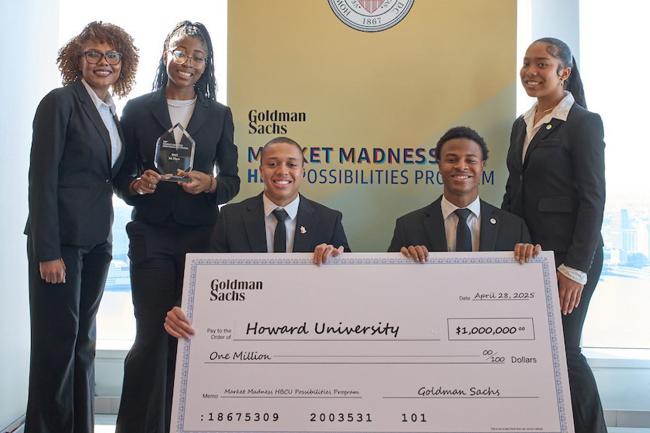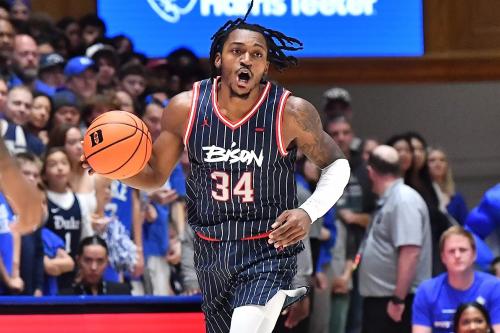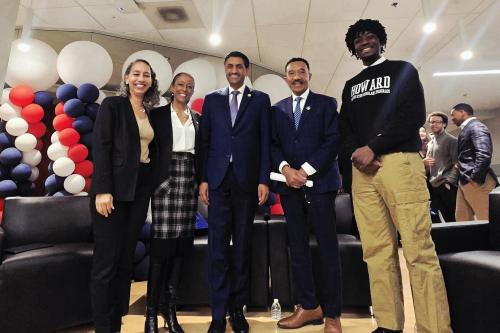“We knew coming in that we wanted to win.”
For the members of the Howard Team that won the Goldman Sachs Fifth Annual Market Madness Competition – Keyla Arrechea, Jordan Atkins, Aaron Harrison, Kadijah Mansaray, and Jada Rabun – competitiveness is innate. When they started the process, more than half of the team had not even finished their first semester in college. They didn’t really know each other. Fast forward a few months, and the three freshman and two sophomores were selected to compete with other schools by proving their business acumen and brought back a $1 million grant for Howard as the victors.
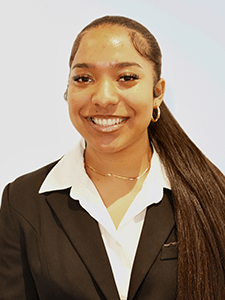
“I honestly don’t think it was even a question for us,” Rabun said. “We knew coming in that we wanted to win.”
Arrechea, Atkins, Harrison, Mansaray, and Rabun were among the Howard participants in Goldman Sachs’ HBCU Possibilities Program for the 2024-2025 academic year, “a semester-long, immersive introduction to key financial concepts and their real-world applications.” Students from 12 HBCUs participated in coursework related to corporate finance and had an opportunity to experience one-of-a-kind professional development and networking opportunities inside the investment banking realm, as well as to learn the corporate operations of Goldman Sachs. The program was part of the company’s multi-year commitment to strengthen HBCUs and recruit talent from the institutions based on their excellence in producing highly competent professionals and the institutions' ability to foster social mobility and drive economic growth.
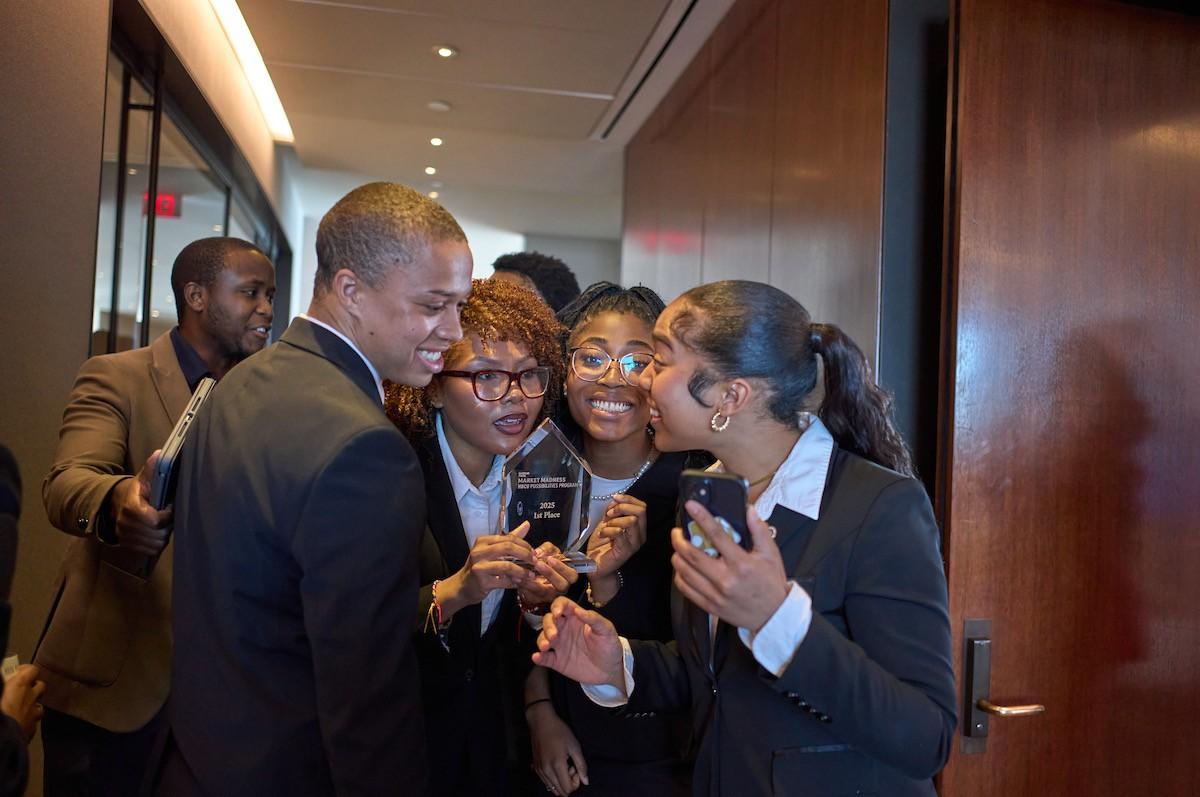
The capstone of the program was a case competition, during which teams were asked to propose and defend a business solution to grow revenue for Amer Sports, a global company which operates in 42 countries and had revenue of $5.2 billion during their past fiscal year, based on a merger, acquisition, or product launch. The Howard team wasn’t intimidated in the least. They proposed selling adaptive wear for people with disabilities through Amer’s Arc’teryx line and have it launch in Dick’s Sporting Goods store in time for the 2026 Paralympics games. Howard’s team was the only team to propose a product launch.
“We were all very flexible and adaptable when it came to working with each other and just taking feedback,” Rabun said. “On a team, everyone's thinking different things, but we can only choose one idea. We were open to each other.”
“It was about selling an experience.”
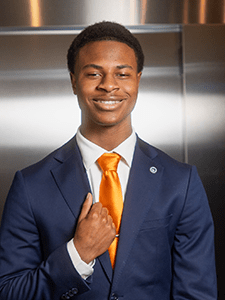
To win, the team made it through two rounds of virtual competition, adjusting after each round to incorporate feedback from judges, and then traveled to New York to present their recommendations in front of Goldman representatives. They calculated projected revenue growth and a forecasted return on investment and analyzed risks, strengths, weaknesses, opportunities, threats, and potential market size.
“We wanted to sell more than a product,” said Harrison. “It was about selling an experience.”
They represent geographically diverse hometowns. Arrechea was born in the Oakland, California area but raised in the country of Colombia. Rabun is from Los Angeles, California. On the other coast, Atkins and Harrison grew up in New Jersey – South Orange and Englewood, respectively. Mansaray is from Alexandria, Virginia. Three of the students were finance majors, one was a computer information systems major, and one was a computer engineering major. Their work ethic, determination, and motivation helped them create the synergy that led them to victory.
“The trait that we all brought was our ambition,” said Harrison. “I think it was our drive that really carried us, because there wasn’t an answer we didn’t have. We went out and found it instead of just giving up or pivoting.”
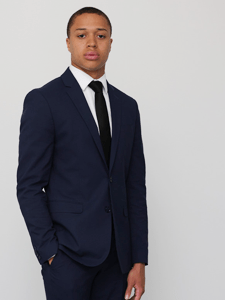
“Our group was really dedicated,” added Atkins. “It was mostly on us to figure out how we were going to meet deadlines. I think as young adults, we did a really good job of managing ourselves and putting in the work to get the job done.”
Four of the five students are in the School of Business, and credit Howard’s unique curriculum for preparing them to easily compete in a competition like the Goldman Sachs contest. Rabun noted that the intensity of their curriculum made the pressure of the competition second nature. They used their training as fuel to push them past the other teams.
“We are used to having the feedback already,” said Rabun. “We are used to having to project and having energy. We’re used to memorizing slides. So when it came to the questions on stage, it was like muscle memory. Howard has definitely prepared us.”
“The positive competitiveness is really what pushes students to want to be their best,” added Harrison. “It’s like kicking the imposter syndrome out of it. You want to do well because the person next to you is doing well.”
Mansaray isn’t in the School of Business, but she feels equally well prepared. Her self- confidence has grown, and she has learned the importance of collaborating with others.
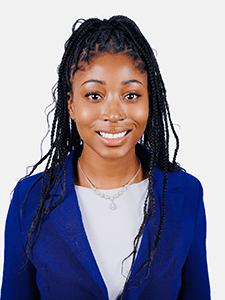
“Howard prepared me in two ways,” she said. “It pushes you out of your shell and it pushes you to network. If you want to do anything, you have to know people, you have to be able to talk to people, and you have to be able to stick up for yourself. I feel like having that ability is essential in case study competitions where you are able to strongly vocalize your opinion. Howard is such an amazing ground for bringing in Black excellence from many backgrounds. We all bring so many different perspectives. We all have such different lived experiences, but we are all very intelligent in our own way. I think that’s what helped put our team at the top, and it’s helped me succeed.”
Arrechea is a team leader in the School of Business’ 21st Century Advantage Program, through which corporate sponsors challenge students to build teams, learn foundational business skills, and think strategically. Older students also mentor younger students. Case analyses are central to the program, and she has led her team of over 20 students through four case analyses this year. She has also provided resume and interview support for her peers. Even though she is just a sophomore, she takes her leadership role very seriously.
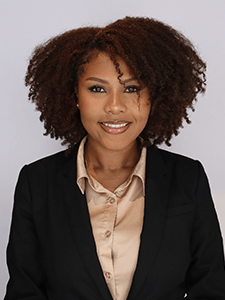
“It’s really about team building and learning how to do case prep and problem solve,” Arrechea said. “In the School of Business, we are their first mentors. We are their first family. The fact that I’ve been able to see their growth means a lot.”
The other team members are equally active in the Howard community. Atkins serves as a student ambassador and is a member of Kappa Alpha Psi Fraternity Inc. Rabun is a member of the Collegiate 100 sponsored by 100 Black Men and has been exposed to stock market investing since high school. While at Howard, Mansaray founded a nonprofit program based on “mentorship, inspiration, resilience and representation” that works with middle school students.
“I founded it about seven months ago to address the psychological barriers that marginalized youth face throughout their academic background, because I once was a marginalized youth,” Mansaray explained. “I came from a low-income background, and I know that a lot of us struggle with imposter syndrome, self-doubt, and other mental health barriers.”
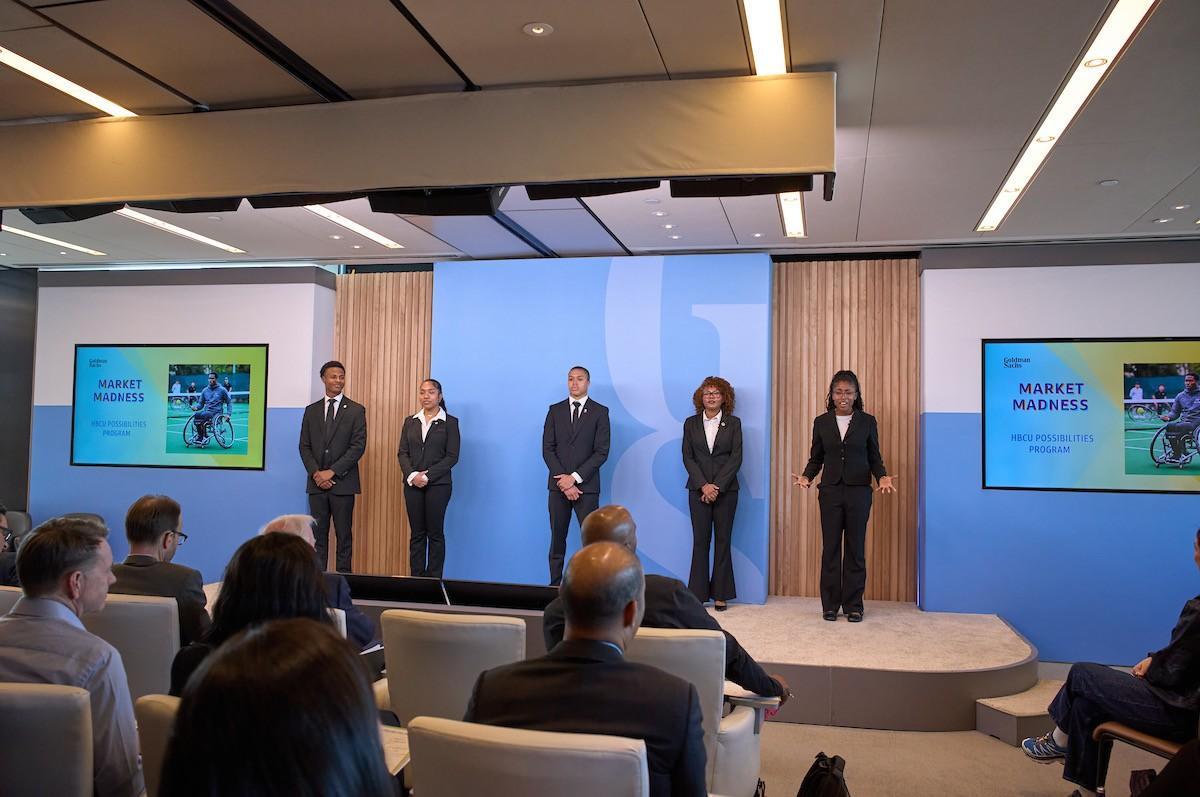
Even though graduation from college is still a way off, each student has their eye firmly fixed on their future. Harrison, for example, wants to jump into the rapidly growing field associated with student athletes’ names, images, and likenesses. Mansaray wants to own her own private equity firm as she takes her nonprofit nationwide. Rabun wants to pursue investment banking and asset management. More immediately, they are taking advantage of the opportunities they have garnered through Howard. Atkins will be working this summer in the wealth solutions field with Blackstone Wealth Management, and Arrechea will leverage the consulting experience she gained last summer as an intern for Deloitte as she goes to work for artificial intelligence leader Nvidia at their Santa Clara headquarters. The common thread among the team members’ future plans was a desire to give back to their communities.
“You can really make a difference in your community through business,” said Atkins. “Throughout my life, I’ve been passionate about investing in Black people.”


